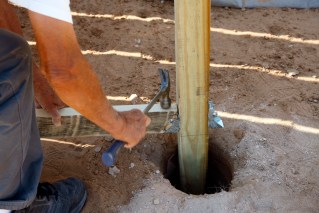Bodhi Farm and other countercultural communities live like the 1970s never ended

Building Gai's kitchen for a lifestyle she has described as "voluntary simplicity". Photo: Supplied
It is just after sunset and someone has blown the conch shell to summon residents to the weekly Sunday community dinner.
Painted by moonlight, silhouetted figures begin to appear in the door frames of houses and strolling up the gravel road.
Soon we’re sharing a meal – vegetarian – with around 20 others in a large, hand-built, hexagonal building that serves as the community centre.
Later, as dishes are dutifully washed and dried, a guitar and mandolin are picked up and folk songs begin to reverberate around the room.
Voices break into familiar harmonies as the words of Neil Young and Joni Mitchell resonate around the hall.
You’d be forgiven for thinking this was a scene from the 1970s, save for the lyrics being read from a smartphone screen held by Michael Pawson, whose son and grandchildren are joining in the singalong.
How the world has changed.
This is Bodhi Farm, an intentional community in northern NSW. And if it seems straight out of the 1970s, that’s because it is.

Bodhi Farm residents gather each Sunday for dinner in the community centre. Photo: Heather Faulkner
The 1970s meets 2019
The community started in 1977 with aspirations to share land in what long-term resident and community archivist Gai Longmuir terms “voluntary simplicity” – a “thoughtful and reflective way to live collectively” in harmony with the natural environment.
It was also founded on an adoption of the five Buddhist precepts: Do no harm, do not steal, do not lie, do not misuse sex and do not consume alcohol or drugs.
The residents sometimes joke that they were “farmers of enlightenment”.
Communities like this were once dismissively labelled as “hippy communes”, yet we are currently facing twin challenges of environmental destruction and unaffordable housing.
Could these surviving countercultural communities hold important lessons?
Bodhi Farm is not typical of Australia’s ’70s countercultural communities in its longevity (or its spiritual foundations).
But neither is it the only one to flourish and endure.

Gai Longmuir says the farm is a “thoughtful and reflective way to live collectively”. Photo: Supplied
While utopian ’70s communities were widely regarded as failures, they’ve gone on to inform and influence the design of modern eco-villages, the tiny house movement, urban intentional communities and myriad minor movements in between.
Now, in 2019, Bodhi Farm residents have a handsome communal building where meals and meetings are regularly hosted.
Decisions are made through a communal consensus process.
The community produces its own power via a solar and micro-hydro system and is proudly off the grid.
It has its own spring-fed water supply.
The houses have been mostly hand-built with recycled materials, usually over a long period of time, and are set in a beautiful regenerated forest.
And they tend to have cost hundreds, rather than hundreds of thousands, to build.
Multiple generations live together, and the kids have free run of a beautiful rainforest “backyard”.

A 1980 photo of one of the original homes at Bodhi Farm in northern NSW. Photo: Col James

The house has since been painted and has gained a few improvements, including solar panels. Photo: Heather Faulkner
Idyllic?
At first glance, Bodhi Farm’s lifestyle seems idyllic.
Its effort to escape from the housing market seems especially attractive with the OECD’s dwelling-price-to-income ratio index for Australia recording a 78 per cent increase between 1980 and 2015.
Many Australians who feel squeezed out of the current housing market are looking to co-operative models as a way of obtaining affordable housing.
There is great interest in simpler, low-impact lifestyles as seen in the tiny house phenomenon, though it is fraught with red tape.
The environmental costs of conventional urban housing construction are also becoming clearer.
And contemporary eco-villages can sometimes be no less expensive than their urban counterparts.
So, Bodhi Farm’s eco-village-type qualities have a lot of appeal.

Gai’s house, viewed from the back. Photo: Supplied
Early days were ‘not quite legal’
But it was hard work for the community to get to this position.
For one, what the young dreamers at Bodhi were doing in 1977 was not quite legal.
Neighbouring Tuntable Falls intentional community residents recall that their application for multiple occupancy (or MO, as it is colloquially termed) hinged on a working toilet.
Their innovative installation of a composting toilet swayed a weary government inspector in their favour.
The land itself was, as Gai describes it, “ravaged”. It was logged and had at some point been used to grow bananas.

Loo with a view: a composting toilet at Bodhi Farm. Photo: Heather Faulkner
Where rainforest now stands, was once a barren hill, full of “bladey grass”.
“It was very marginal land,” says Gai. “It was cheap.”
While experiments in communal living blossomed in 1970s Australia, they were by no means mainstream.
Often dismissed as drop-out hippies, communities like Bodhi Farm found their desires to live a different kind of life were not always understood or tolerated by locals.
“Have they told you about the baby stealing,” quipped one Bodhi original resident, referring to one of the many rumours that were circulated about the community.
Many locals thought their new and sometimes naked neighbours were dirty and uneducated. It was far from the truth.
University educated and widely travelled, they may not have been trained architects or gardeners, but they brought with them philosophies of community –many had returned from experiences in India – that were foreign to rural Australians, and they were determined for their buildings to enable the kind of society they wanted to create.
“When I first went travelling as a 21 year-old,” says Gai, “I vividly remember flying over what was then Portuguese Timor and looking down at what would have been the approaches to Dili.”
The simple thatched houses amid the bougainvillaea, replete with children running among the structures, resonated with her.
“I had a visceral sense of it being a pattern I really liked – the pattern of village and community,” she says.

Community garden caretaker Michael Pawson. Photo: Supplied
“I had done a long Buddhist meditation retreat, and that made me look for a spiritual community – not just an ordinary lefty [community]”, adds Michael, who joined Bodhi Farm in 1978 and is the current resident caretaker of the community garden (and a doting grandfather).
With no electricity and no real houses, the community started in tents, trailers, a converted bus, and then built more-robust dwellings when amenities and supplies were available – hence the recycled materials.
Michael’s home resembles a castle.
“I wanted to have an interesting house because I wanted to have an interesting life,” says Michael.
What started out as a lean-to in 1978 (“We just put up four poles on a floor and a roof and didn’t really have walls,” he says) was expanded when children began arriving.
But when a large tree branch took out a corner of the house during roofing repairs, Michael spotted water damage.
“Timber’s too tasty to termites,” he says. And so, he decided to build out of cement.
Based on a design he sketched, the building began to take shape.
“Brick by brick, barrow by barrow,” was the way to go, says Michael, who built the house himself as he could afford materials.
“I didn’t really have plans,” he admits, “I just sort of launched into it and problem-solved as I went along.”
Building stopped when Michael suffered a ruptured aneurysm.
By that time, the place needed lifting and restumping – a task Michael was no longer able to do himself.
But ingenuity seems to be Michael’s forte; He simply excavated underneath the structure and restumped it that way.
“I didn’t quite finish it,” says Michael of the house. Though he hopes to get back to it in the future, he is realistic about it: “The arthritis is kicking in now”.
The threat of building inspections weighed heavily on residents’ minds.
Not much was built to code in the early days and they relied on the goodwill of council inspectors to continue.
Most of the early residents didn’t have jobs. They pooled their money to buy materials for the community.
Cars were shared and maintained by a self-taught mechanic.
“We were quite young,” says Gai of the sparseness of Bodhi’s early days.
“I think we were very undemanding of what life might serve us, and grateful for what we got.”
It’s a sentiment that, with 21st century hindsight, “almost makes me want to cry”, she says.

The largest boulder in this photo fell from the cliff above last year, damaging a column of this Bodhi Farm house. Photo: Heather Faulkner
It takes a village …
Then came the children. The challenges of a growing community were exhausting.
Though the socio-economic conditions at the time made it possible to establish the settlements – through allowing some residents to remain on the dole – raising families was incredibly difficult.
A commitment to extended forms of kinship often helped.
The adage that “it takes a village to raise a child” was almost literally applied as kids roamed the community, looked after by whichever adult was present.
People also began to go outside to find work to support their growing families, and facilities such as electricity and water.
Relationships were strained, but the community endured.
Gai treasures that sense of community.
“In our increasingly fragmented society, the bonding and continuity that we have been able to create for ourselves, the sense of place and mutual protection, is, for me, like a deep anchor to life,” she says.

The challenges facing Bodhi Farm today are a far cry from those faced in ’77. Photo: Heather Faulkner
The impact of age
The challenges facing Bodhi Farm today are a far cry from those faced in ’77.
They have safe, comfortable homes (“Don’t forget to unlock the door on your way out” is the motto here).
And they even have wi-fi (how else to share the lyrics for a song written nearly 50 years ago?).
Bush trails have been tamed into level roads. It is quaint, it is comfortable and yet, its future is uncertain.
The original founders – those who have stayed on – are ageing. This is no Shangri-La.
At the monthly community meeting we attended, attracting new people was a top item on their talking board.
The cost to join the community is well-below current market trends, though repairs and maintenance will be expected to be footed by new community members.
But it’s not an easy entry into the community. There is a two-year trying-out period to settle into Bodhi Farm.
They are careful about who they welcome as a permanent resident.
Someone will be needed to maintain the electricity grid, powered by the sun and creek flows.
The system still needs maintenance, and a brilliant mind to upgrade its performance as technologies change.
Climate change is on their minds as well.
Shifting weather patterns are making the once-abundant creek-water supply more tenuous. No rain means no water.
There are other challenges, such as ongoing needs for carpentry, mechanics and child care that the community must solve together.
But they know from more than 40 years of living experience at Bodhi Farm, that change is inevitable, but not new.
They will adapt.
Multimedia documentary storyteller Heather Faulkner (Griffith University) and architectural historian Lee Stickells (University of Sydney) are researching the origin stories of 1970s Australian intentional communities. The Way Out Down Under project can be followed on Instagram: @_wayoutdownunder_








